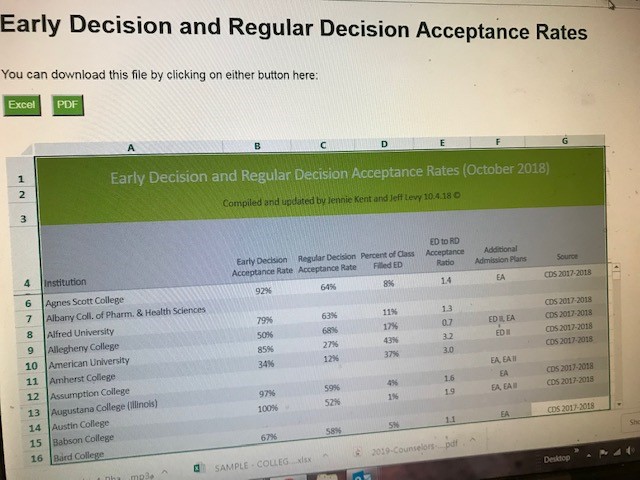Early Decision results and Early Decision II – an increasingly popular option

Notifications for Early Decision (ED), Restricted Early Action (REA) and Single Choice Early Action (SCEA) have been delivered. This year, as in previous years, there were many more tears than fist-bumps.
This following list prepared by College Kickstart (www.college-kickstart.com) was released and includes: the name of the institution. the number of ED/REA/SCEA applicants, number admitted and the ED, REA and SCEA acceptance rates:
| Institution (Plan) | Applied | Admitted | Rate | Link |
|---|---|---|---|---|
| Bowdoin (ED1) | 820 | Link | ||
| Brown (ED) | 4,562 | 800 | 18% | Link |
| Connecticut College (ED1) | 207 | Link | ||
| Cornell (ED) | 6,615 | 1,576 | 24% | Link |
| Dartmouth (ED) | 2,069 | 547 | 26% | Link |
| Duke (ED) | 4,300 | 887 | 21% | Link |
| Emory (ED1) | 1,812 | 725 | 40% | Link |
| Georgetown (REA) | 7,305 | 856 | 12% | |
| Harvard (SCEA) | 6,424 | 895 | 14% | Link |
| Johns Hopkins (ED) | 2,399 | 682 | 28% | Link |
| MIT (EA) | 9,291 | 687 | 7% | Link |
| Pomona (ED1) | 120 | Link | ||
| Princeton (SCEA) | 791 | Link | ||
| Santa Clara (ED1/EA) | 8,280 | 4,554 | 55% | Link |
| Georgia (EA) | 16,511 | 7,025 | 43% | Link |
| Notre Dame (REA) | 7,300 | 1,542 | 21% | |
| UPenn (ED) | 6,453 | 1,269 | 20% | Link |
| Virginia (ED) | 2,157 | 749 | 35% | Link |
| Virginia (EA) | 25,063 | Link | ||
| WUSTL (ED1) | 708 | Link | ||
| Yale (SCEA) | 5,777 | 796 | 14% | Link |
Students who were rejected or deferred now find themselves in phase two of their application process. Many will examine their lists more closely to reevaluate their thoughts on which schools are “reach,” “target,” and “safeties.”
There is a relatively new wrinkle in college admissions called Early Decision II (ED II). Traditional ED programs have a November 1 deadline and a December notification. ED II deadlines are typically January 1 with notification by mid-February. This extra time allows students who were deferred or denied from their first choice school to apply with a binding decision, and perhaps a boosted opportunity to another college.
According to my latest research, the following 75 colleges and universities offer ED II:
- American University
- Babson College
- Bates College
- Boston University
- Bennington College
- Bentley University
- Bowdoin College
- Brandeis University
- Bryant University
- Bryn Mawr College
- Bucknell University
- Carleton College
- Case Western Reserve University
- Claremont McKenna College
- Colby College
- Colgate University
- College of the Atlantic
- College of the Holy Cross
- College of William and Mary
- College of Wooster
- Colorado College
- Connecticut College
- Davidson College
- Denison College
- Dickinson College
- Emory University
- Franklin & Marshall College
- George Washington University
- Gettysburg College
- Grinnell College
- Hamilton College
- Harvey Mudd College
- Haverford College
- Hobart and William Smith Colleges
- Juniata College
- Kenyon College
- Lafayette College
- Lehigh University
- Macalester College
- Middlebury College
- Mount Holyoke College
- New York University
- Northeastern University
- Oberlin College
- Occidental College
- Pitzer College
- Pomona College
- Reed College
- Rensselaer Polytechnic Institute
- Rhodes College
- Saint Olaf College
- Santa Clara College
- Sarah Lawrence College
- Scripps College
- Sewanee: The University of the South
- Skidmore College
- Smith College
- Swarthmore College
- Syracuse University
- Trinity College
- Trinity University
- Tufts University
- Tulane University
- Union College
- University of Chicago
- University of Miami
- University of Richmond
- Vanderbilt University
- Vassar College
- Wake Forest University
- Washington University
- Washington and Lee University
- Wellesley College
- Wesleyan University
- Whitman College
Benefits of ED II
ED II allows students more time to prepare their strongest application. That may mean rewriting their Common Application essay or refining their supplemental prompts or it may mean another chance to take the standardized tests. ED II also gives students with strong performance in their first semester senior year additional grades to share with colleges. According to Sally Rubenstone, Senior Advisor at College Confidential (www.collegeconfidential.com) “Applying Early Decision does give students a bit of an admissions-odds boost at most colleges. Admission folks are usually willing to lock in strong-but-not-spectacular candidates whom they know will show up in September.”
Why do colleges offer an ED II program option?
Colleges really like Early Decision I and Early Decision II because accepted students are committed to attend, and that increases their yield numbers and the yield number impacts their rankings. Additionally, it helps the admissions office shape the class by allowing them to be pickier with the regular decision applicants. As an example, if a student’s big advantage is that they play the oboe and that was a hole the admissions office filled with an ED I or II applicant, it will be more challenging for that student to be accepted in regular decision.
Potential Disadvantages
Rubenstone also shares that “there can be some financial disadvantages to applying ED in any round because an affirmative decision will eliminate your chance to compare multiple aid packages. But, on the other hand, if an ED school does not offer reasonable aid then it’s okay to wheedle out of the so-called “binding” commitment.”
Bierer is an independent college adviser based in Charlotte. Send questions to: lee@collegeadmissionsstrategies.com; www.collegeadmissionsstrategies.com





